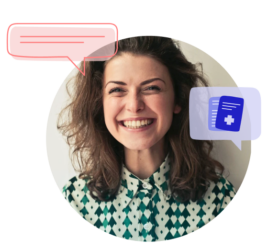A virtual medical receptionist? No, we’re not proposing robots taking over.
Efficiency is key in our fast-paced world. The last thing you want as a healthcare provider (or as a patient) is to have your time wasted. In parallel with the rapid growth in automation and AI to better serve patients, practices across the country have also seen staffing issues run rampant.
Leveraging smart solutions to give you back hours is nearing on a necessity at this point.
Solutions like a virtual medical receptionist; a digital helper who can take on the mundane tasks while you focus on more complex patient needs. Giving you tools to help you get more done during the day.
Understanding Virtual Medical Receptionist role
Reception and administration are integral parts of how a healthcare practice operates, forming the backbone of patient-practice interactions. In traditional settings, the role of a receptionist is pivotal but often inundated with repetitive, time-consuming tasks.
Consider the hours your front desk or receptionist staff dedicate to phone calls, meticulously extracting necessary patient information through an exhaustive list of questions. This process, albeit crucial, is not only labor-intensive but prone to human errors, leading to potential miscommunications and inefficiencies. Moreover, patients often find themselves entangled in lengthy phone trees or waiting queues, striving to reach the right person for assistance. This scenario not only strains your staff but also impacts patient satisfaction negatively.
Using technology to make things simple
While it may sound new-agey, the virtual medical receptionist, is a transformative approach (powered by platforms like OhMD) to make complicated communication workflows, simple. These virtual assistants redefine patient interaction through automation and streamlined communication. By integrating OhMD’s tools, practices can automate the collection of patient data, schedule appointments, and even handle routine inquiries, all without a single phone call. This shift from traditional phone-based systems to a more dynamic, digital interface significantly reduces the administrative burden on your staff.
Furthermore, virtual receptionists are not just about efficiency; they are about enhancing the patient experience. Instead of getting angry with wait times, patients enjoy a more personalized and immediate interaction.
Gone are the days of staff being tied in 1-to-1 phone calls. While the virtual medical receptionist works, staff can be responding to many other patients at the same time. Patients provide their information and receive updates in a more convenient, less intrusive manner. This level of accessibility and ease not only elevates patient satisfaction but also fosters a stronger trust in your practice.
Adopting a solution like this is more than just a technological upgrade; it’s a strategic move towards operational excellence. It empowers your practice to handle high volumes of patient interactions seamlessly while ensuring accuracy and patient privacy. By embracing this innovation, healthcare practices can significantly reduce wait times, enhance data management, and provide a more patient-centered service, ultimately leading to a more efficient and effective healthcare delivery system.
Your Virtual Medical Receptionist in practice…no pun intended
In the most simple illustration of using OhMD as your Virtual Medical Receptionist, the patient skips the phone queue by texting in their requests or information, OhMD automates the information collection, and then alerts you to the conversation.
Using Autopilot, the patient is automatically prompted with questions for various customizable workflows. Upon the patient answering the questions, practice staff are given a summary of their responses so they can follow up as needed. The time-consuming part of the workflow is automated, and the staff can focus on getting the patient to the best outcome.
Some of my patients prefer to call, what about them?
What about those who prefer to call? Not everyone opts for texting, after all.
Patients can call in and choose to wait to talk to a person, or they can opt to leave a voicemail.
Where’s the time savings there?
Well, rather than spending the time listening to voicemails and documenting all the necessary information, you can get a transcription of their message placed directly into their patient chat. OhMD’s Call-to-Text feature eliminates the task of manual voicemail transcription, while keeping patient information in one continuous thread.
Call-to-Text really shines when you consider the patient perspective. Imagine calling your provider and being met with the following: “Press 1 to continue the convo over text, press 2 to leave a voicemail, press 3 to remain on the line to speak with a live member of staff over the phone”.
There’s no doubt that options like the above make staying in touch easier and more convenient. But, it gets even better when paired with Autopilot. When Call-to-Text and Autopilot team up, your phone menu could now say “Press 1 to hang up and request a prescription refill by text message, press 2 to hang up and schedule an appointment by text, press 3 to leave a voicemail, press 4 to stay on the line and speak with a live member of our staff.”
The above is just one example of how Call-to-Text and Autopilot could be used in tandem. We know that every workflow and every practice are unique, so we’ve made the platform flexible enough to customize everything to your specific need.
Better outcomes for patients, better outcomes for practices
Technology has transformed medical reception. Implementation of automated systems takes the time-consuming tasks from your staff, saving time and costs. It also adds convenience – an easily accessible system for both users and patients, streamlining your processes and improving communication. We’ve seen practices that reduced wait times from months to weeks just by employing automation that could intake patient information, run eligibility and begin the scheduling process.
The Impact of Virtual Medical Receptionists on Healthcare Practices

Letting automation take on repetitive and time-consuming tasks is not only cost-effective but crucial to elevating your medical practice.
Think about how much time you could save your front desk staff if they didn’t have to spending time calling patients, writing down voicemail information, and sending faxes. Automating voicemail transcription, referral management, and patient outreach can greatly benefit your practice.
Enhanced Patient Satisfaction and Care
Virtual medical receptionists play a crucial role in enhancing patient satisfaction and care. By streamlining the appointment scheduling process, they reduce wait times and improve overall patient experience. Handling of basic administrative tasks grants your healthcare staff the bandwidth to make their patient experience more personal. Overall, you’ll see improved efficiency, leading to better patient outcomes and a positive experience.
How do I choose? Analyzing your practice’s needs and requirements
When considering a virtual medical receptionist for your practice, it’s important to analyze your specific needs and requirements. Start by evaluating the workload of your current medical receptionist to determine if additional support is necessary. Consider the cost-savings of incorporating a virtual medical receptionist, granting your employees the time and bandwidth to perform other necessary tasks. Additionally, think about the flexibility and scalability of a virtual receptionist service, which can easily adapt to changes in your practice’s needs.
Assessing the financial implications and benefits of a virtual medical receptionist is crucial for determining its cost-effectiveness. By reducing administrative costs associated with hiring and training in-house staff, a virtual receptionist can streamline operations and improve efficiency. Could a virtual medical receptionist can also work as an assistant to your front desk staff? It is possible the solution could allow them to focus on making the patient experience personal while spending less time on the more tedious and repetitive tasks. It’s important to consider these benefits when deciding if a virtual medical receptionist is the right choice for your practice.
How to Transition from Traditional to Virtual Receptionist Services
To transition from traditional to virtual receptionist services, start by evaluating your current receptionist setup. Identify tasks that can be easily handled by a virtual receptionist. Research and compare different virtual receptionist service providers based on features, pricing, and customer reviews. Train your staff to work with virtual receptionists and establish clear communication channels.
Steps to Implementing a Virtual Medical Receptionist in Your Practice
To successfully implement a virtual medical receptionist in your practice, communicate will be key. You’ll need to speak with your staff about the transition, train them on how to integrate the virtual receptionist into their workflow, and implement the system after proper setup and integration. Staff will need time to adjust with using automated tools, monitoring for asynchronous text threads rather than hearing the phone ringing constantly.
Adapting Your Practice to New Technological Solutions
Adapting your practice to new technological solutions is essential for staying ahead in the healthcare industry. Virtual medical receptionist services offer a cost-effective way to enhance efficiency, improve patient satisfaction, and save on administrative costs. To make the transition, assess your practice’s needs, research software providers, communicate with your staff, and monitor performance to ensure a smooth implementation. Be proactive. Take a leadership role in embracing new technologies that can provide optimal patient care.
What Does the Future Hold for Virtual Medical Reception?

The future of virtual medical reception looks promising, with advancements in technology and increasing demand for remote healthcare. AI can further these sophistications and create suggestions based on patient profiles and messages. As telemedicine grows, virtual receptionist software will play a crucial role in managing appointments and maintaining efficient communication.
You’ve read about the benefits and how easy it is to implement a virtual medical receptionist software. Now it’s time to decide what’s right for your practice.
It may be hard to imagine a healthcare practice whose phone calls have decreased by 50%. Or one whose wait times have been slashed by 96%.
But these are real cases of practices that have seen these outcomes after incorporating OhMD into their patient communication. It’s time to revolutionize your practice – take the first step by scheduling a demo with one of our experts.

Interested in automating your healthcare reception?
Features like Autopilot, Virtual Phone Assistant and two-way texting can elevate your practice.
See how OhMD can innovate your office!



